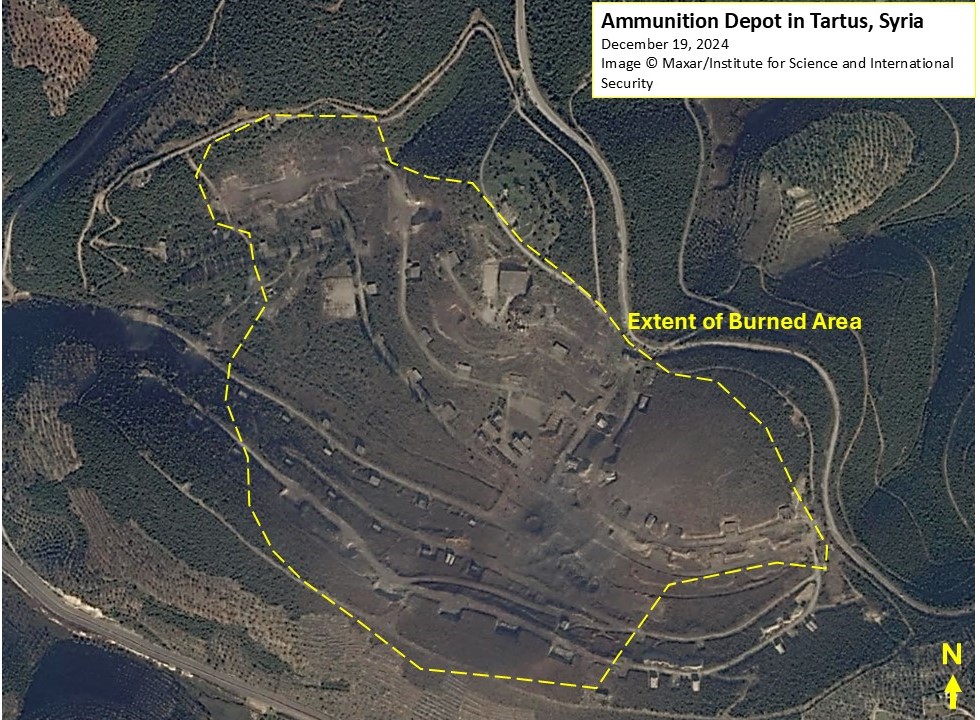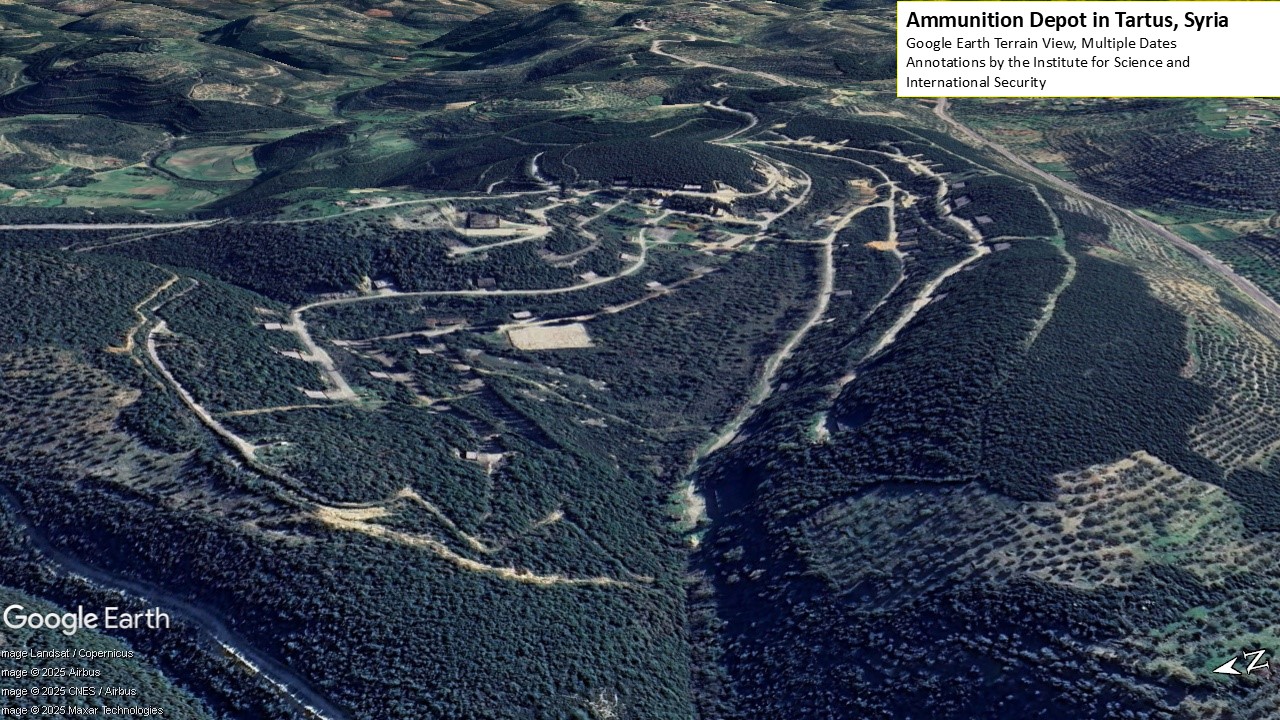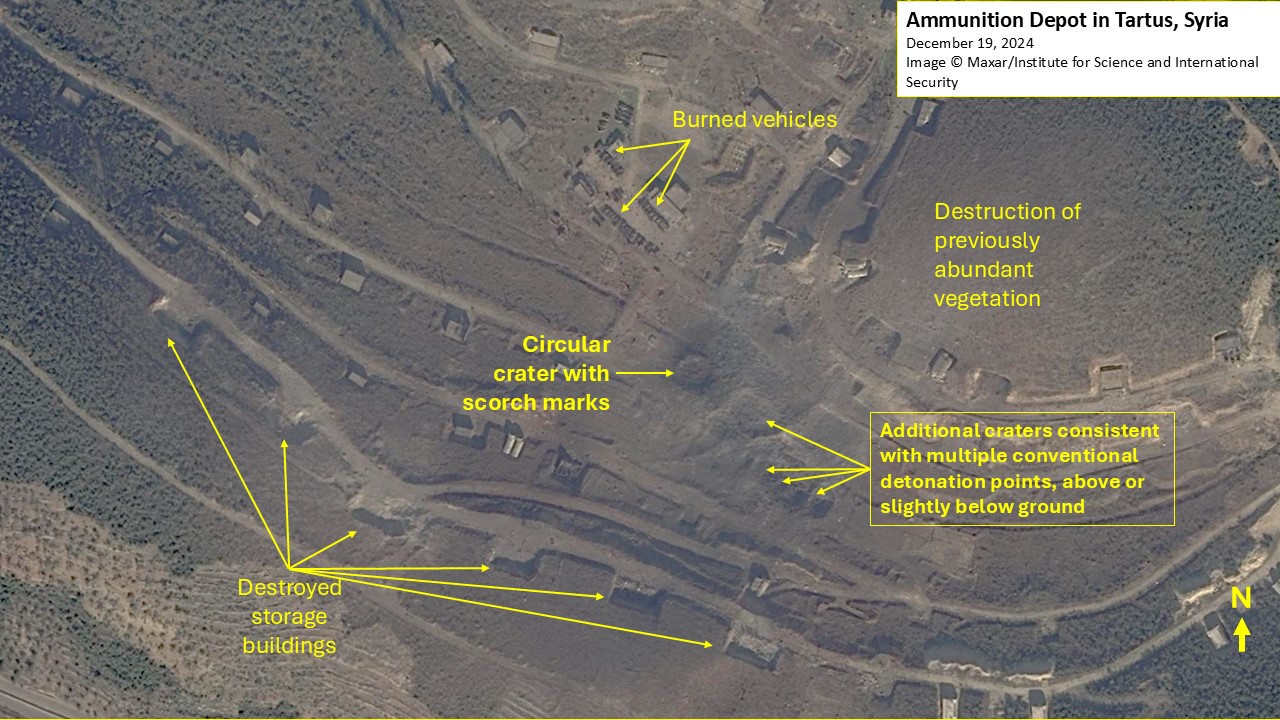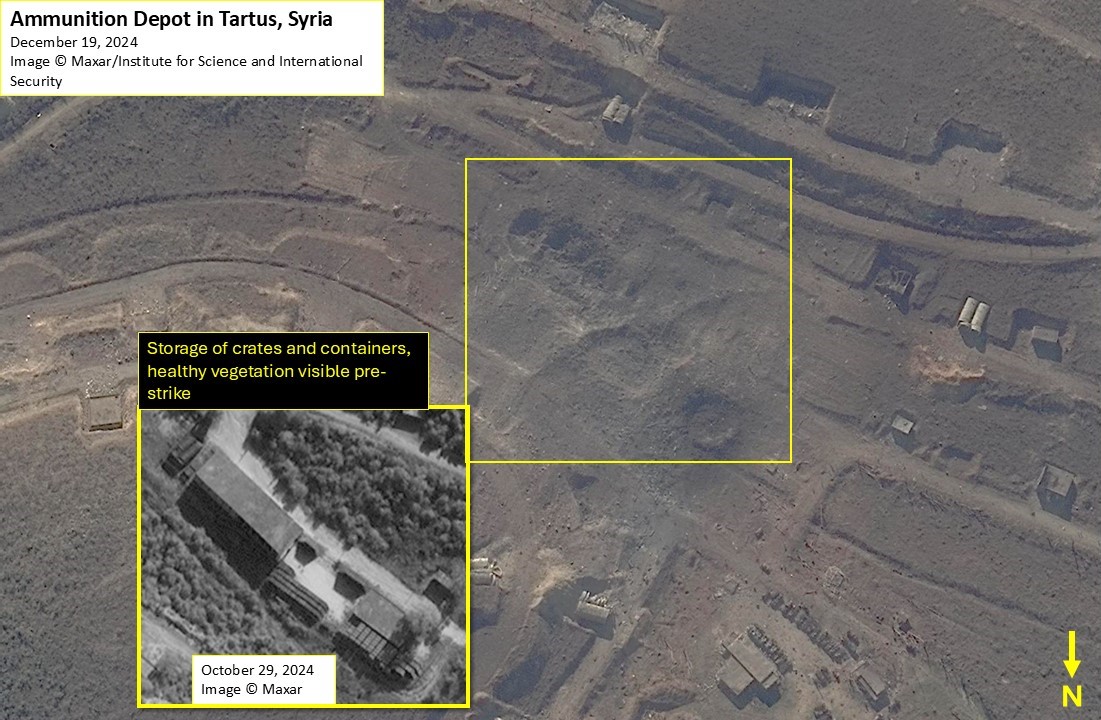Some media reports and popular accounts on social media have claimed that Israel detonated a low-yield tactical nuclear weapon in the region of Tartus, Syria, on the night of December 16th. This claim can be disproved in several ways.
Normally, we ignore claims like this. However, with the claim recently reappearing in an official journal of the influential Islamic Revolutionary Guard Corps (IRGC), and Iran embroiled in intense discussions about whether to build nuclear weapons, this false report could lead to misunderstandings. It could accelerate an Iranian regime decision to build nuclear weapons. It could also lead the Iranian regime and its military to miscalculate that the use of tactical nuclear weapons is acceptable. It could also lead to a global perception that the taboo on the use of nuclear weapons has been broken, with dangerous consequences in other parts of the world. Because of these considerations, this misinformation is dangerous, and we decided to examine it critically.
While multiple sites in or near the region of Tartus were attacked that night, one strike specifically drew considerable attention because a major explosion occurred, with a fireball visible from miles away. At the same time, seismic stations registered a small seismic event indicative of an explosion. Later, social media posts falsely linked some routinely elevated background radiation readings in Cyprus to this event.
Instead of stemming from a nuclear explosion, these effects can be traced to conventional explosions. The most likely cause is a combined explosion of Israeli weapons and munitions stored at the attacked site. There is no evidence that indicates nuclear weapon use, and many points of evidence speak directly against it.
Background
Israel struck multiple targets in the Tartus region the night of December 16th, many of which were small surface-to-air missile sites, according to data validated by officials. Many of these strikes were widely reported in media publications. Regardless of the site attacked, none of the attacks could have been a nuclear explosion, based on a wide variety of considerations.
One strike stands out in the available public reporting, with footage of a large explosion lighting up the night sky circulating in social media. The origin was most likely a strike on an ammunition depot in a hilly area a few miles north-east of the coastal city of Tartus, Syria. Long before the strike, it was known as a Syrian military storage site. The coordinates are 34°55'30"N, 35°59'30"E. Multiple fires at the site were detected by NASA satellites on the night of December 16th, 2025. It is credible that these explosions were large enough to have caused the seismic event reading in the nearby areas.
Most media reports stuck to identifying the targets and reporting on the massive explosion, reporting, for example, "the strikes targeted Syria's 23rd Air Defense Brigade headquarters in addition to the munitions warehouses belonging to the Syrian Army's 107th missile brigade and other storage sites containing surface-to-surface missiles and ammunition." [1] Other outlets however picked up misinformation spread on social media, including the mistaken assessment that unusual spikes of radiation were detected in nearby monitoring stations in Europe.
Claim
According to Muslim Network TV, for example:
"Israeli Defense Forces reportedly destroyed a scud missile facility. However, speculation has arisen about the possible use of a small nuclear weapon in the attack. The strike caused a 3.0 magnitude earthquake, felt as far as Iznik, Türkiye, 820 km away. Russian media claimed Israel launched a new missile from a warship, while other reports suggest the use of a B61 nuclear bomb, developed by the US. The EU's Radioactive Environmental Monitoring detected a spike in radiation levels in Türkiye and Cyprus 20 hours after the explosion." [2]
Other posts on social media reiterated the nuclear weapons claim, basing it also on the appearance of a mushroom cloud after the explosion.
Iranian media also falsely reported this event. The most significant and worrisome in terms of influence on decision-making in the Iranian regime is the reappearance of this misinformation in a January 13, 2025, article in the IRGC Basirat Journal, which serves as an influential platform within the Iranian regime for disseminating strategic content consistent with the interests of Iran's leadership and used by policymakers and influential figures to gauge public sentiment or justify decisions. Worse, the author(s) put the misinformation about the detonation of a tactical nuclear bomb in Tartus as indicating that "they were pursuing military action against Iran."
Mushroom Cloud and Detonation of High Explosives.
An above ground nuclear explosion is typified by the formation of a mushroom cloud. However, a mushroom cloud is not unique to a nuclear explosion; large amounts of high explosive will also generate a mushroom cloud. And others have misattributed mushroom clouds to nuclear explosions, such as the many people on Twitter ascribing the 2020 Beirut blast, which killed so many and did such widespread damage, to a nuclear weapon blast.
A mushroom cloud forms after a large conventional or nuclear explosion as a result of a combination of heat, pressure, and the rapid movement of air. The explosion creates an extremely hot fireball, rapidly heating the adjacent air, causing it to rise rapidly. The explosion creates a shockwave, accelerating surrounding air, sucking up air above the explosion into a column of hot gases and debris. As the hot air rises, it cools and condenses, forming a cloud. As the updraft continues, the characteristic stem of the "mushroom" shape emerges. The top of the column starts to spread out, creating the cap-like shape of the mushroom cloud.
In this case, both column and cloud formation were visible in videos circulating on social media (see Figure 1).

Figure 1. Screenshot from a video of the explosion circulating in social media. Source: https://x.com/VanessaBeeley/status/1868444119510761504
Radiation Measurements
Even a low yield nuclear detonation, particularly one detonated on the surface or just below it, would generate an intense amount of local radioactive fallout. No such radiation was or has been reported to date. Common fission products in fallout, e.g. cesium 137 and strontium 90, have long half-lives and would be readily detectable today. In fact, they would pose a serious radiation risk as they worked their way into groundwater and food and as the cesium 137 continued to emit gamma radiation to people in the area where the fallout was deposited. However, there have been no reports of elevated radiation levels in the Tartus region.
The Comprehensive Nuclear-Test Ban Treaty Organization's (CTBTO) worldwide radiation monitoring system did not detect any radiation. This system, with 100 monitors in 80 locations, is designed to detect characteristic fission products from a nuclear explosion.
Some of the misinformation circulating on social media was that readings of gamma radiation (which is emitted in large amounts from the fallout of a nuclear explosion) in Cyprus were elevated after the attack. However, an alleged "spike" of about 60 nanosieverts per hour (nSv/hr) is well within normal radiation background levels and consistent with normal variations in daily measurements. Moreover, it only appears as a spike if one reduces the scale dramatically and focuses on a small number of days. In its color-coded map, the European Commission's Radiation Environmental Monitoring uses a scale from 0 to over 2000 nanosieverts per hour, and intervals of 100, where all readings from 0 - 100 nSv/hr are categorized in the lowest category. [3] A surface or near surface nuclear explosion would have caused far larger radiation readings at many environmental monitoring stations. That did not occur.
When nearby stations in Turkey are considered, fluctuations up to 60 nSv/hr are common. It should be emphasized that these values are extremely low, relative to what to expect from a nuclear explosion, and are due to background levels of radiation.
Seismic Information after the Explosion
The European Mediterranean Seismological Center (EMSC) and the CTBTO reported an event on the night of December 15/16. For example, a station in the Jordan-Syria region detected an event with a mL 2.2. The EMSC reported that a nearby station recorded an mL of 3. For a seismic station within a few hundred kilometers of a surface explosion, the mL is typically more accurate and appropriate for characterizing the size of such an event. In addition, a surface event with mL values in this range is viewed as relatively small and unlikely to be measured at distant stations due to the attenuation of the energy in the seismic waves.
The CTBTO determined that this event was not a naturally occurring earthquake and investigated the event, according to officials. The CTBTO uses a standard procedure in such cases, where it assumes the event was a nuclear explosion with the yield recorded at its stations. It then generates a model of the explosion estimating the amount of produced fission products that would be carried by the winds in fallout. Using local and regional meteorological data, it projects the path of the fallout plume, estimating expected radiation depositions or readings. According to officials, it concluded that there was no evidence that the event on December 16th was a nuclear explosion.
However, an event of this magnitude is within the scope of large conventional military or industrial explosions.
A Large, Conventional Explosion
It appears that the conventional bombing(s) by Israel created sympathetic detonations of conventional warheads stored, which is not unusual. That generated a seismic wave, which was detected at local stations, which is also not unprecedented; other conventional explosions have led to similar effects.
The Lebanese port explosion in 2020 is a recent example that shows that non-nuclear explosions caused by the storage of large amounts of explosives can lead to a large explosion. It reportedly caused a magnitude of 3.3. Another example is the September 2024 Ukrainian attack on a Russian ammunition depot in Toropets, Russia, which generated an estimated magnitude 2.8, caused by the substantial destruction of the ammunition depot and the type of munitions stored there.
Satellite Imagery Analysis
We evaluated the sites attacked the night of December 15/16, 2024. One site stood out, based on available information.
Summarizing, we know the seismic signal was from an explosion. We also know the sites attacked on the night of December 15/16. We also know the estimated epicenter of the seismic reading, which is for a surface explosion unlikely to be exact. Seismic coordinates for areas that have near surface explosions contain a bias error and can be off by many kilometers.
Social media reporting focuses on an ammunition depot north-east of the city of Tartus, consisting of dozens of bunkered storage buildings/structures built into the hillsides as well as ground-level, or slightly below ground, storage of crates and containers. Upon evaluating post-strike satellite imagery and considering the above, this site emerged as the most likely origin of the visual explosion and seismic reading.
Figure 2 is a Google earth terrain view that shows the valley and the surrounding hills with bunkered structures.
Post-strike high resolution imagery shows significant damage at the site, with not all, but many, structures leveled or completely destroyed (see Figure 3). However, multiple craters are visible, indicating individual starting points of explosions. Additionally, the distance between some of the damaged sites indicates that multiple strikes occurred or there were sympathetic detonations from the main blast and/or from fire ignition.
Most notably, a large, circular crater is visible in post-strike imagery taken December 19, 2024 (see Figure 4). The crater measures about 16-20 meters in diameter. Scorch marks inside and around the crater are visible, as well as small amounts of remaining debris. Additional craters are visible nearby. Nearby military trucks appear burnt-out. The surrounding area, where healthy vegetation was abundant before the strike, now appears arid.
The size of the crater is consistent with a conventional explosion, caused by a combination of delivered explosives with munitions stored at the site.
A comparison of pre- and post-strike images shows that the main crater is right where a large ground level storage of crates and containers was before, with the additional craters lining up with additional storage buildings/structures, consistent with multiple explosions fueled by munitions stored there combining into one big explosion (see Figure 5).
Last Word and Judgement
The event on December 16, 2024, was not a nuclear explosion. The widespread misinformation demonstrates an appalling lack of knowledge about nuclear weapons, seismological investigations, and radiation monitoring. It also shows how dangerous false claims of the use of nuclear weapons can be. In this case, the misinformation increases the risk of Iran building nuclear weapons and believing, along with others, that the use of tactical nuclear weapons is acceptable in a conventional war or exchange. It is incumbent on Iranian media and officials to either debunk this story, or if unwilling, to present its "evidence" in the context of the CTBTO procedures, so the world can have a look.
Figure 2. Google Earth terrain view shows storage buildings and structures built into the hillsides at the munitions depot in Tartus, Syria.

Figure 3. An overview of the ammunition depot after the strike shows the large amount of destruction at the site.
Figure 4. Post-strike imagery shows signs consistent with conventional bombing(s) and sympathetic detonations from the main blast and/or fire ignition.
Figure 5. Visible craters in post-strike imagery lineup with storage structures visible before the strike. (The pre-strike image of October 29, 2024, is used for visual comparison due to a similar view angle to the December 19 image; an image dated closer to the attack, December 10, shows the storage structures and crates/containers were still present.)
1. Hana Levi Julian, "Israel Destroys Syrian Weapons Stockpile in Latakia, Tartus," December 16, 2024, The Jewish Press, https://www.jewishpress.com/news/middle-east/syria/israel-destroys-syrian-weapons-stockpile-in-latakia-tartus/2024/12/16/. ↩
2. "Did Israel use a nuclear bomb in Syria? Radiation spike sparks speculation," Muslim Network TV, December 31, 2024, https://www.muslimnetwork.tv/did-israel-use-a-nuclear-bomb-in-syria-radiation-spike-sparks-speculation/. [↩]
3. See: https://remap.jrc.ec.europa.eu/Advanced.aspx [↩]









